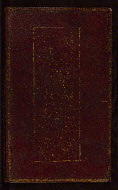Home > Digitized Walters Manuscripts
This document is a tranformation of a TEI P5 XML manuscript description incorporating images. If you have trouble reading special or non-Latin characters on this page, please make sure you have appropriate Unicode fonts installed and an up-to-date web browser.
Walters Ms. W.649, Burning and melting
Browse images (Browse images in a new window) | TEI in XML format
W.649
Burning and melting
Vernacular: سوز وگداز
As-written name: Muḥammad Riz̤ā Nawʿī Khabūshānī
Supplied name: Nawʿī Khabūshānī (d. 1019 AH / 1610 CE)
Name, in vernacular: محمد رضا نوعي خبوشاني
Note: Name supplied by cataloger
This is an illuminated and illustrated copy of the poem Sūz va gudāz (Burning and melting) by Nawʿī Khabūshānī (d. 1019 AH / 1610 CE), which recounts the love story of a Hindu girl who burns herself on the funeral pyre of her betrothed. The codex was written in nastaʿlīq in black ink by Ibn Sayyid Murād al-Ḥusaynī and illustrated by Muḥammad ʿAlī Mashhadī in 1068 AH / 1657 CE. According to the colophon, Ibn Sayyid Murād al-Ḥusaynī copied the manuscript for the painter Muḥammad ʿAlī, the “Mani of the time,” as a “souvenir.” The fact that the manuscript was produced for one of the most prolific artists of seventeenth-century Iran makes it a highly significant document. It opens with an illuminated incipit with headpiece (fol. 1b) and closes with an illuminated tailpiece with colophon (fol. 21b). Text pages have interlinear illumination and small rectangular and triangular pieces with polychrome floral and scrolling vine motifs. There are eight miniatures in a style associated with the Safavid centers of artistic production of Mashhad and Isfahan (fols. 5a, 9a, 10b, 13a, 14a, 16a, 17b, and 19b).
1st Ṣafar 1068 AH / November 1657 CE
Iran
As-written name: Muḥammad ʿAlī Naqqāsh Mashhadī
Name, in vernacular: محمد علي نقاش مشهدي
As-written name: Ibn Sayyid Murād al-Ḥusaynī
Name, in vernacular: ابن سيد مراد الحسيني
Book
Literary -- Poetry
The primary language in this manuscript is Persian.
- Transliteration: Aḥqar ʿibād Allāh ibn Sayyid Murād al-Ḥusaynī bar sabīl-i yādkārī /1/ bi-jihat-i mānī al-zamānī afz̤al al-muṣavvirīn Ustād Muḥammad /2/ ʿAlī Naqqāsh-i Mashhadī marqūm qalam-i shikastah /3/ raqm kardānīd taḥrīran ghurrah-i Ṣafar sanat 1068 /4/
- Translation: The most lowly servant of God ibn Sayyid Murād al-Ḥusaynī copied it with a broken pen as a souvenir for the Mani of the time, the most excellent of painters, master Muḥammad ʿAlī, the painter from Mashhad. It was copied in the first of the month of Safar in the year 1068 [November 1657].
- Comment: Gives the name of the calligrapher, the painter, and the date of completion of the copy
Paper
Laid paper
Foliation: ii+22+i
Catchwords: Written obliquely on versos
14.5 cm wide by 23.5 cm high
7.0 cm wide by 16.0 cm high
- Columns: 2
- Ruled lines: 16
- Title: Sūz va gudāz
- Author: Muḥammad Riz̤ā Nawʿī Khabūshānī
- Scribe: Ibn Sayyid Murād al-Ḥusaynī
- Artist: Muḥammad ʿAlī Naqqāsh Mashhadī
- Incipit: الهى خنده ام را نالكى ده ...
- Hand note: Written in nastaʿlīq script in black ink
- Decoration note: Eight miniatures (fols. 5a, 9a, 10b, 13a, 14a, 16a, 17b, and 19b); illuminated incipit with headpiece (fol. 1b); illuminated tailpiece with colophon (fol. 21b); interlinear illumination; framing lines in blue, gold, and red; small rectangular and triangular pieces with polychrome floral and scrolling vine motif on gold ground on text pages
fol. 1b:
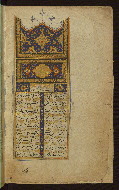
- Title: Illuminated incipit with headpiece
- Form: Incipit
- Text: Sūz va gudāz (Burning and melting)
- Label: This illuminated incipit with headpiece bears the basmalah in the lower rectangle.
fol. 2a:
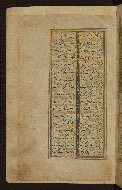
- Title: Illuminated text page
- Form: Text page
- Text: Sūz va gudāz (Burning and melting)
- Label: Verses of the poem Sūz va gudāz (Burning and melting) are written in nastaʿlīq in black ink. Framing lines in blue, gold, and red surround the text, and a border of polychrome floral motifs on a blue ground divides the verses.
fol. 5a:
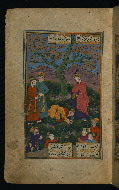
- Title: The author Nawʿī Khabūshānī prostrates himself before Prince Dāniyāl
- Form: Illustration
- Text: Sūz va gudāz (Burning and melting)
- Label: The author Nawʿī Khabūshānī prostrates himself before Prince Dāniyāl, son of Emperor Akbar, to whom he dedicated this poem.
fol. 9a:
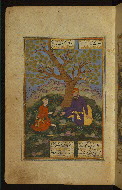
- Title: Youth confesses his falling in love to his father
- Form: Illustration
- Text: Sūz va gudāz (Burning and melting)
- Label: Set in India, the story begins with a young Hindu man confessing his strong love for his childhood friend to his father. His father consents to the young man’s request to marry and sends a message to the girl’s parents.
fol. 10b:
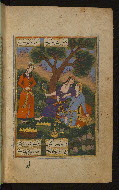
- Title: Young Hindu girl prepares herself for her wedding
- Form: Illustration
- Text: Sūz va gudāz (Burning and melting)
- Label: The young woman, in female company, prepares herself for her wedding. She is shown in the center of the composition holding a mirror.
fol. 13a:
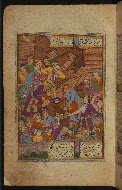
- Title: Bridegroom is buried under a collapsed building
- Form: Illustration
- Text: Sūz va gudāz (Burning and melting)
- Label: On the morning the young man and woman were to be wed, the bridegroom travels to the home of his beloved. On his way, he stops to rest in a mud building. As a result of heavy rains, the structure falls and buries the bridegroom and his companions alive.
fol. 14a:

- Title: Bride with mourners carrying the bridegroom's coffin
- Form: Illustration
- Text: Sūz va gudāz (Burning and melting)
- Label: Overcome with grief, the young Hindu woman accompanies her bridegroom’s coffin to the funeral pyre and decides to commit sati (self-immolation).
fol. 16a:

- Title: Young Hindu girl before the Mughal Emperor Akbar
- Form: Illustration
- Text: Sūz va gudāz (Burning and melting)
- Label: The Mughal Emperor Akbar attempts to dissuade the young Hindu girl from committing sati (self-immolation).
fol. 17b:
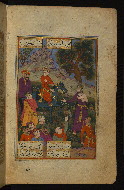
- Title: Prince Dāniyāl accompanies the young Hindu girl to the funeral pyre
- Form: Illustration
- Text: Sūz va gudāz (Burning and melting)
- Label: Emperor Akbar eventually permits the young Hindu girl to practice sati (self-immolation). Akbar's son, Prince Dāniyāl, accompanies the woman to the funeral pyre.
fol. 19a:
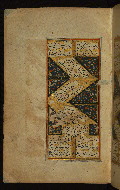
- Title: Text page with illuminated triangular pieces
- Form: Text page
- Text: Sūz va gudāz (Burning and melting)
- Label: This text page has triangular pieces with a polychrome floral and scrolling vine motif on a gold ground. The verses, in nastaʿlīq script in black ink, are written obliquely in the center of the page.
fol. 19b:
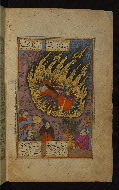
- Title: Hindu couple united on the funeral pyre
- Form: Illustration
- Text: Sūz va gudāz (Burning and melting)
- Label: The young Hindu girl has thrown herself on her beloved’s funeral pyre. The historic Hindu practice of self-immolation or widow-burning, called sati, was an uncommon subject for Persian literature.
fol. 21b:
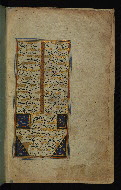
- Title: Illuminated tailpiece with colophon
- Form: Tailpiece with colophon
- Text: Sūz va gudāz (Burning and melting)
- Label: The colophon with illuminated tailpiece indicates that the calligrapher of this work was Ibn Sayyid Murād al-Ḥusaynī, who copied it as a “souvenir” for the “Mani of the time,” the master Muḥammad ʿAlī, a painter from Mashhad, in the month of Safar in the year 1068 AH [November 1657 CE]. It reads as follows: Aḥqar ʿibād Allāh ibn Sayyid Murād al-Ḥusaynī bar sabīl-i yādkārī /1/ bi-jihat-i mānī al-zamānī afz̤al al-muṣavvirīn Ustād Muḥammad /2/ ʿAlī Naqqāsh-i Mashhadī marqūm qalam-i shikastah /3/ raqm kardānīd taḥrīran ghurrah-i Ṣafar sanat 1068 /4/
Previous binding lower board outside:
The binding is not original.
Modern western black leather binding (without flap); earlier red goatskin binding with gold-tooled frames attributable to the thirteenth century AH / nineteenth CE housed separately
Walters Art Museum, 1931, by Henry Walters bequest
Richard, Francis. Splendeurs persanes: manuscrits du XIIe au XVIIe siècle. (Paris: Bibliothèque nationale de France, 1997), 220.
Farhad, Massumeh. “Searching for the New: Later Safavid Painting and the Suz u Gawdaz (Burning and Melting) by Naw`i Khabushani.” Journal of the Walters Art Museum 51 (2001): 115-130.
Principal cataloger: Gacek, Adam
Catalogers: Landau, Amy; Smith, Sita
Editor: Bockrath, Diane
Conservators: Jewell, Stephanie; Quandt, Abigail
Contributors: Barrera, Christina; Emery, Doug; Herbert, Lynley; Noel, William; Simpson, Shreve; Tabritha, Ariel; Toth, Michael B.; Valle, Chiara
The Walters Art Museum
Licensed for use under Creative Commons Attribution-NonCommercial-ShareAlike 3.0 Unported Access Rights, http://creativecommons.org/licenses/by-nc-sa/3.0/legalcode. It is requested that copies of any published articles based on the information in this data set be sent to the curator of manuscripts, The Walters Art Museum, 600 North Charles Street, Baltimore MD 21201.
